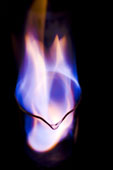Reactions of alcohols

The presence of the -OH functional group allows alcohols to undergo a series of reactions.
Combustion
They are generally highly flammable and can be used as fuels.
When combusted in a supply of air or oxygen they will burn to form carbon dioxide and water as shown by these two examples.
2 CH3OH + 3 O2 → 2 CO2 + 4 H2O
(Methanol)
CH3CH2OH + 3 O2 → 2 CO2 + 3 H2O
(Ethanol)
Petrol in Australia can contain up to 10% ethanol. Ethanol does not release quite as much energy per litre as the main component of petrol, octane. However, it does burn efficiently (generally with a cleaner flame than alkanes), and produces slightly less carbon dioxide.
Other oxidation reactions
Combustion is a type of oxidation, but more interesting are other oxidation reactions of alcohols.
When our bodies absorb alcohol, oxidation reactions convert the ethanol into other products such as aldehydes which can be removed from the body.
Oxidation reactions are also the cause of foods and drinks containing alcohol 'going off', such as wine converting to vinegar in the presence of oxygen.
It is in these reactions that primary, secondary and tertiary alcohols behave very differently as you will see later.
Reactions with carboxylic acids
These reactions, which are called condensation reactions, produce another type of organic chemical called esters.





